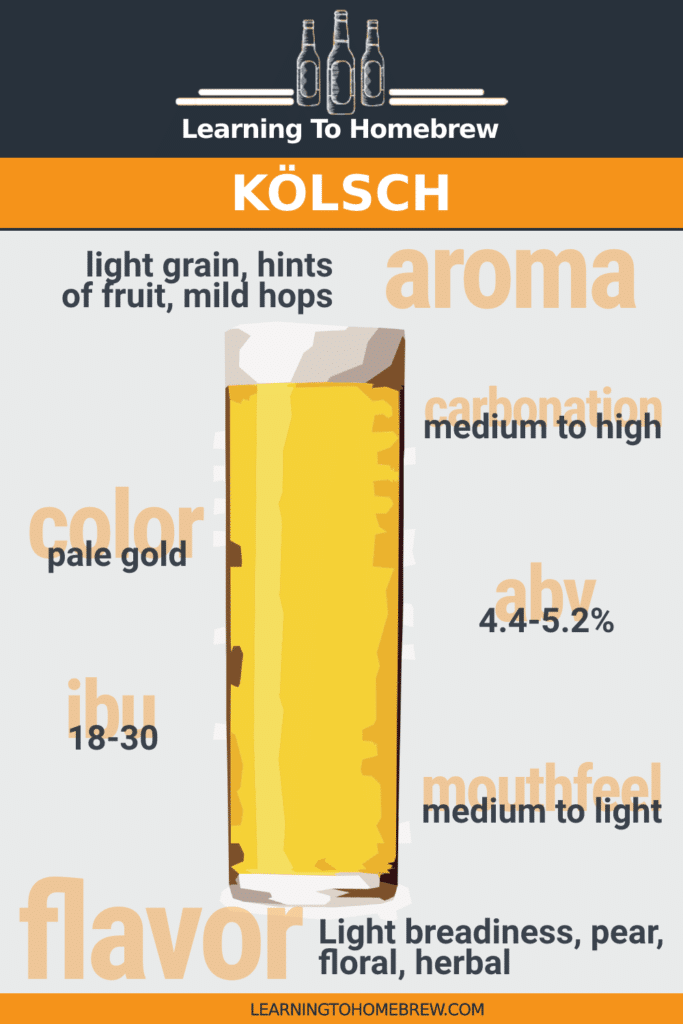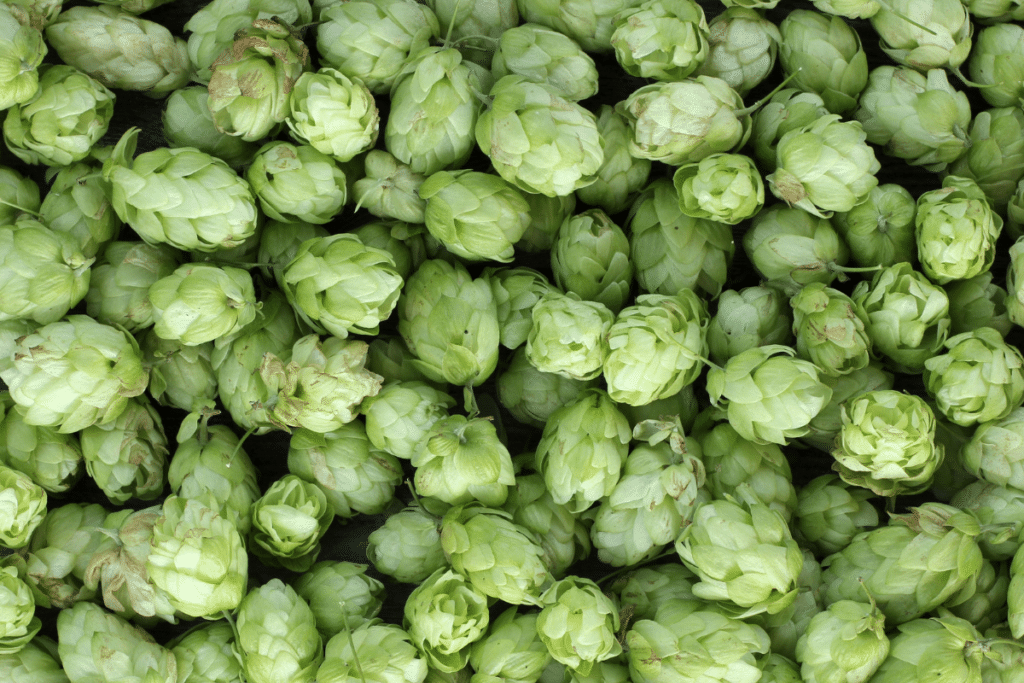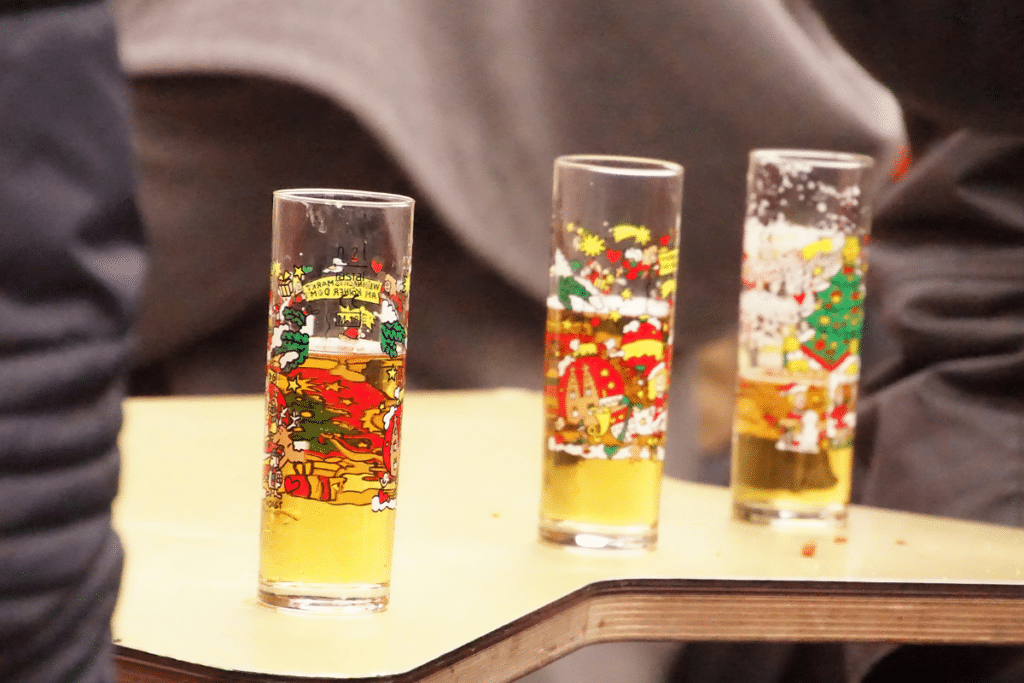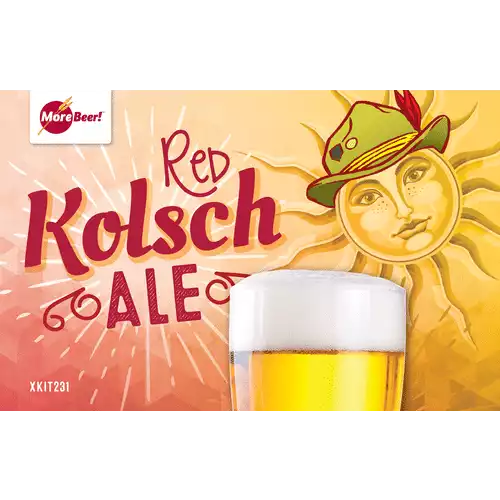Test your brewing skills by brewing a delicate Kölsch. This light style will challenge your ability to brew a clean well balanced beer that subtly combines malts, hops, and hints of fruit.
Brew an exquisite Kölsch with a soft water profile that leans towards chlorides over sulfates. Use pale malts such as German Pilsner, Vienna Malt, and wheat malt. For specialty grains, use acidulated malts or Light Munich. Ferment with a clean ale yeast at low temperatures. Finally, use German hops to balance the brew.
Keep reading to learn how to brew a Kölsch worthy of Cologne. I’ll go over each aspect of the recipe as well as the brewing process step by step.
Topics We Cover
What is a Kölsch?
Unlike many beers, you can’t brew a proper Kölsch in your home setup – in fact, you can brew one in the United States, no matter the size of your brewery. Because of its geographically protected status. The good news is that you can brew a great Kölsch-style beer without too much trouble.
The Kölsch is a delicate hybrid lager that brings malt, hop, and fruit flavors together. This balancing act creates a pale lager-like beer that has a touch of bitterness to even it all out. Most Kölsch beers have an overall subtle impression.

Defining characteristics of Kölsch-style include:
- Color – Pale gold, 3.5-5 SRM
- Common flavor – Light breadiness, pear, floral, herbal
- Aroma – Light grain, hints of fruit, mild hop characteristics
- Mouthfeel – Medium to light body, medium to high carbonation
- IBUs (Bitterness) – 18-30
- ABV – 4.4-5.2%
Your typical German-Style Kölsch will have lightly sweet malt flavors such as breadiness or even honey. These malt flavors are paired with hints of fruit–often pear or apple. On top of these flavors are soft hop characteristics. Most beers in this style will lean into floral or spicy notes.
The appearance of this beer is quite pale with a short-lived pure white head. Upon the first sip, you will discover a smooth beer with a body on the lighter side of average. Like many lighter beers, a Kölsch is decently carbonated.
History of the Kölsch beer
Kölsch beer originated in the city of Cologne or Köln, Germany. It was first brewed in direct reaction to bottom-fermenting beers becoming more popular in the region. To combat this popularity, Cologne brewers began lagering the beer after fermenting with ale yeast. It wasn’t until 1918 that the style was named Kölsch.
Cologne was against the use of bottom-fermenting yeast in the extreme. Brewers in the region were made to swear they would only use top-fermenting yeast. The city went so far as to outlaw the sale of beer that wasn’t top-fermented. While this attitude contributed to the creation of Kölsch, it was not the primary factor. That was the introduction of the lagering process to Cologne brewing practices. Cologne brewers first started doing this in the mid-1700s.
After the style was dubbed Kölsch in 1918, it slowly grew in popularity. In 1985, the Kölsch Konvention – created by 24 local breweries – set the qualifications a beer must meet to be called Kölsch. The most important is that it must be brewed in or around Cologne.
Later, in 1997, the EU recognized this by granting the style-protected geographical indication status. Outside of the EU, many breweries make Kölsch-style beers though like sparkling wine is to Champagne, they aren’t a true Kölsch.
Popular commercial Kölschs
For the beer enthusiasts and the beer curious, here’s a quick list of Kölschs you should try:
- Gaffel Kölsch – This Kölsch from one of the 24 breweries of the Kölsch Konvention is light, refreshing, and easily drinkable.
- Reissdorf Kölsch – Reissdorf is one of the main breweries that remain from the 24 breweries. Their Kölsch has notes of honey, fruits, and light toast notes.
- Mühlen Kölsch – Another authentic Kölsch. This one has a clean profile with hints of fruitiness and hop bitterness.
- Goose Island Summertime – This American Kölsch style beer is a fruity example of the style. This beer is crisp, refreshing, and great for a hot summer night.
Popular Kolsch recipe kits (all-grain or extract)
An interesting take on a Kölsch. Inspired by our craving for German Kölsch Beers, we tried to capture the drinkability but enhance the color and maltiness.
Imagine an ale beer that is ruby in color and drinks like a lager!
How to brew a Kölsch
Once you’ve explored some great examples of Kölsch (whether authentic or not) you may be thinking of how to brew your own. In order to brew the best beer you need to know the style forward and backward. To that end, I will break down everything you need to know.
Authentic Kölsch-style beers require a soft water profile similar to that of Köln (Cologne), where it was first brewed. Use a pale malt such as a German Pilsner; specialty grains are not required, although an acidulated malt can be used. Ferment with a clean ale yeast, then finish with German hops.
Let’s start by going over some great choices for the recipe and ingredients. Then, we can look at the process, including brew day, fermentation, and bottling.
Recipe and ingredients
While you can’t have beer without fermentation, you can’t get anywhere without quality ingredients. There are, of course, no wrong ingredients, but some will go together much better than others.
As always, start with your water. Since beer is nearly 90% water, good water makes good beer. Then consider your grain bill, hops, and finally, yeast. Each one can have a significant impact on your final product.
Water profile
While you’re limited to brewing a Kölsch-style beer, the most authentic versions will be as close as possible to the original. In this case, the water profile used should be similar to that found in Köln, Germany.
A Kölsch style beer calls for a soft water profile with a chloride-to-sulfate ratio of 2:1. This will enhance the crispness of the beer and let the malt flavors shine. Start with reverse osmosis (RO) or distilled water.
While a balanced style, using fewer sulfates will prevent the beer from being overly harsh. The chloride focus will instead allow the malt flavors to shine. If you prefer slightly more hop bitterness you can make the ratio closer to a 1:1.
Since this beer does not use any dark malts, you will need to include some form of acid for the mash if you’re doing an all-grain brew. Check out this article for a more detailed breakdown of the best water profile for Kölsch.
Base grains
The best base grains for a Kölsch are light malts such as a German Pilsner. This will bring sweet malt, honey, and slightly bready flavors. This malt can make up the majority of your grain bill.
Another great choice includes Vienna malt. This will provide the backbone of subtle malt flavors this style needs. If you feel like adding your own flair, any pale malt will do. Another option is to mix these options at various desired ratios.
Some brewers will use wheat malt in small quantities to help enhance head retention. Of course, this is not traditional to the style if you are going for purity.
Specialty grains or other additions
Specialty grains are not essential for a Kölsch.
That said, the use of acidulated malt or a light Munich malt can be acceptable. Keep any specialty additions on the light side to keep the SRM down.
For those interested in traditional brewing methods, acidulated malt is one way to lower the mash pH without using acid directly in the mash. A light Munich malt will add rich malt flavors that will serve to add complexity.
Hops
A Kölsch calls for hops both for bittering and flavor.
Hops are useful in this style to provide a balance to the malt flavors. German hops are most traditionally appropriate.

While German hops are the most common choice, you can experiment with other varieties. Hop flavors are meant to be balanced with malt flavors in this style. The two ways this is achieved are by bittering and adding flavors. Be sure not to add too much bitterness to remain in the style.
Bittering
Bittering hops added early in the boil will go through a process called isomerization. This is what gives a beer its bitterness.
A Kölsch calls for anywhere from 18 to 30 IBUs. Since this is not a particularly high IBU count you don’t need hops with extremely high AA concentrations.
Here are some good choices for bittering hops.
| Name | Purpose | Alpha Acid % |
|---|---|---|
| Tettnang | Flavor + Aroma | 2.5-5.5% |
| Saaz | Flavor + Aroma | 2.5-4.5% |
| Hallertau | Flavor + Aroma | 3.5-3.5% |
| Magnum | Bittering | 12-14% |
Aroma and flavor
Aroma and flavor hops added towards the end of the boil don’t add much bitterness. Instead, they add oils that provide flavor and aroma.
Kölsch beers can make use of a mid-boil addition to add bitterness and flavor.
Here are a few good choices to get you started.
| Name | Flavor/Aroma | Alpha Acid % |
|---|---|---|
| Tettnang | Woody, floral, citrus, cream | 2.5-5.5% |
| Saaz | Woody, floral, citrus, cream | 2.5-4.5% |
| Hallertau | Herbal, woody, floral | 3.5-3.5% |
| Spalt | Spicy, floral | 2.5%-5.7% |
Yeast
Generally, the yeast strain for a Kölsch should not add much to the beer. It just needs to consume the majority of the fermentable sugars.
The best yeast to use in a Kölsch is one that is highly attenuating, medium flocculation, and ferments clean. Ester production is less of a consideration as this style is usually fermented on the lower end of the temperature range.
The style allows for some ester production though it should not be overpowering.
Dry
Below are some good dry yeast options for a Kölsch.
| Name | Attenuation | Flocculation | Temperature Range |
|---|---|---|---|
| Safale US-05 | 78-82% | Medium | 64.4-78.8°F |
| Safale K-97 | 80-84% | Low | 59-68°F |
| LalBrew Köln | Medium to High | Medium to High | 54-68°F |
Liquid
Below are some good liquid yeast options for a Kölsch.
| Name | Attenuation | Flocculation | Temperature Range |
|---|---|---|---|
| Wyeast 2565 | 73-77% | Low | 55-60°F |
| WLP029 | 72-78% | Medium | 65-69°F |
| Wyeast 1007 | 73-77% | Low | 55-68°F |
Brewing process
After acquiring all of your ingredients you can move on to brew day. What you do on brew day can have just as much impact on your results as your choices of ingredients. On brew day, one of the most important aspects is sanitization. Be thorough when sanitizing.
All grain, partial, and extract brewing each have important considerations for you to make. When doing all-grain or partial brewing you need to consider mashing and sparging. From there the other considerations are similar. The boil step and on is the same for all three.
Let’s break down each step with the Kölsch in mind. In general, treat this beer similar to a lager.
Mashing
The mash for a Kölsch should be a simple single infusion. The mash should be an hour long. To set up a dry finishing beer, mash on the lower end between 147°F and 149°F.
You should not need to mash any longer than an hour with the light malts used. Keep in mind that you will need to reduce the pH to hit the 5.2 to 5.5 range. This can be done with acidulated malts or lactic acid.
Boil
After the mash and lauter, prepare for the boil.
A Kölsch boil should be a simple hour-long boil. Hop additions are typically at the beginning though halfway through is also common. Any late boil additions should be light as hop flavors should not be overwhelming.
In some cases, you will add all of your hops at the beginning of the boil. Since most of the noble hops are low in alpha acid concentration you won’t get excessive IBUs.
As the boil is finishing it is a good idea to use a fining agent. This style calls for an exceedingly clear final product. This can be achieved by lagering later but everything you can do to assist this process is worthwhile.
Whirlpool or flameout
After the boil for your Kölsch you can whirlpool.
This step is not essential to the style though it can help collect any trub. Some recipes use this time to add some hops for flavor. This is not necessary for a Kölsch.
Generally, this step is out of your way, but if you don’t mind taking the time to set up a whirlpool, go ahead. If you add hops during this stage, don’t add any hops on the latter half of the boil. Adding hops at this stage will transfer enough of the flavor for this style.
Fermentation
Here is where things get a little different for a style with top-fermenting yeast.
A Kölsch should be fermented at a lower temperature than normal for ale yeast. That said, keeping the temperature consistent is still important. Fermentation will take slightly longer since this is a lower temp than normal.
If you are using a lager strain, the temperature will be slightly higher than normal.
After primary fermentation finishes, be sure to lager the brew for at least a week if not two. A month would be best.
Temperatures
The recommended temperature for primary fermentation for a Kölsch is around 60°F. If necessary for your yeast strain you can move that up to 65°F. When you get to secondary fermentation, keep the beer just above 32°F but no higher than 40°F.
This lower temperature will result in slower fermentation with less ester production.
Bottling or kegging
The debate between bottling and kegging will go on for as long as brewers have a choice. It is truly up to personal preference and setup.
Traditionally, Kölsch is stored in kegs and consumed quickly. A Kölsch should not be aged.
That said, there is nothing wrong with bottling a Kölsch if you prefer.
Kölsch recipes
If you aren’t one to create your own recipes here are a few that you can follow for great results. These recipes are from various brewers as credited below.

- JZ FRUH – Kolsch (All Grain)
- Kolonel Kölsch (All Grain)
- Three by Five Kolsch (Extract)
JZ FRUH – Kolsch (All Grain)
This recipe comes from user B. Freymuller on Brewer’s Friend.
Ingredients
- German Pilsner – 7.5 lbs
- American Carapils – 1 lb
- Spalt hops – 1.25 oz
- WLP029
Method
- Heat 2.7 gallons to 148°F.
- Add grain bill and mash for 1 hour.
- Mashout.
- Collect 7 gallons of wort.
- Boil for 60 minutes. Add the Spalt at the beginning.
- Flameout and transfer to the fermentor.
- Cool and pitch yeast.
- Maintain 60°F during primary fermentation.
- After 2 weeks in primary transfer to secondary.
- Maintain near-freezing temperatures for 2 weeks to a month.
- Rack to keg or bottles. Enjoy!
Kolonel Kölsch (All Grain)
This recipe comes from user Herr Braumeister on Brewer’s Friend.
Ingredients
- German Pilsner – 7 lbs
- German Vienna – 2 lbs
- German Dark Wheat – 8 oz
- Perle hops – 1 oz
- Saaz hops – 1 oz
- Whirlfloc
- Safale K-97
Method
- Heat 3 gallons to 148°F.
- Add grain bill and mash for 1 hour.
- Mashout.
- Collect 6.5 gallons of wort.
- Boil for 60 minutes. Add the Perle at the beginning.
- At 5 minutes left add the whirlfloc.
- At 1 minute left add the Saaz.
- Flameout and transfer to the fermentor.
- Cool and pitch yeast.
- Maintain 60°F during fermentation.
- Transfer to secondary. Lager at near-freezing temps for at least 2 weeks.
- Rack to keg or bottles. Enjoy!
Three by Five Kolsch (Extract)
This recipe comes from user Rellif on Brewer’s Friend.
Ingredients
- LME Pilsen – 3.3 lbs
- DME Pilsen – 4 lbs
- Canadian Light Munich – 0.5 lb
- German Light Munich – 0.5 lb
- US Carapils – 0.5 lb
- Domestic Hallertau hops – 1 oz
- Perle hops – 1 oz
- Crystal hops – 1 oz
- Wyeast 2565
Method
- Heat 3 gallons of water for your boil.
- Add the steeping grains when the water is around 140°F.
- Remove the grains when the water is around 170°F.
- When a boil is reached, add the malt extract.
- Boil for 60 minutes. Add the Domestic Hallertau right away.
- At 15 minutes left add the Perle and Crystal.
- Flameout and transfer to the fermentor.
- Cool and pitch yeast.
- Maintain 60°F during fermentation.
- After 2 weeks rack to secondary for 2-4 weeks.
- After secondary fermentation, rack to keg and force carbonate or bottle condition.
Did you know that we have a full library of homebrew beer recipes for every style?






